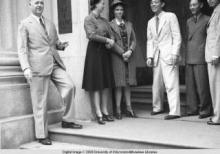The Summer Palace and another land grab.
Primary tabs
Submitted by Andrew Craig-Bennett on Sat, 2010-05-01 21:12
I propose to pass quickly over the rest of the Second Opium War, which of course broadened out beyond the private war between Bowring and Yeh and extended up the length of the coast of China and ultimately to Beijing. Harry Parkes features prominently in this story as one of the Ambassadors kidnapped and tortured (some to death) by the Chinese government whilst trying to negotiate a Peace treaty which is why the British and French forces burned down the Summer Palace.
If you visit the Summer Palace today you will find notices everywhere stating that "This building was burned down by the British and the French.."
I once remarked to a Chinese colleague that, "We British also burned down the White House, but the Americans don't make such a fuss about it" to which the reply was,
"That's different, you are cousins!"
Parkes survived this, as well as the three assassination attempts made on him by Ninjas in the service of the reactionaries during his 14 years as Ambassador to Japan.
His arch-emeny Yeh Ming-chen did not do so well; he was captured by the British and taken to India as a prisoner of war. Once there, he refused to eat Indian food, so as soon as he had run out of Chinese food he starved himself to death. Which goes to show that, like Bowring, he was, despite his intellect, a Very Silly Man.
The eventual peace treaty (the Convention of Peking, 1860)resulted in the cession of Kowloon as far North as Boundary Street.
Here's a handy map:

The dark blue bit is the territory gained as a result of the First Opium War, in 1842; the slightly paler bit is the addition of Kowloon as far as Boundary Street but the map is not quite accurate because Stonecutters' Island (the island just to the west of Boundary Street) was also ceded at this time. The pale grey area is the New Territories acquired on a 99 year lease after the Boxer Rebellion, which we'll be getting to shortly...
If you visit the Summer Palace today you will find notices everywhere stating that "This building was burned down by the British and the French.."
I once remarked to a Chinese colleague that, "We British also burned down the White House, but the Americans don't make such a fuss about it" to which the reply was,
"That's different, you are cousins!"
Parkes survived this, as well as the three assassination attempts made on him by Ninjas in the service of the reactionaries during his 14 years as Ambassador to Japan.
His arch-emeny Yeh Ming-chen did not do so well; he was captured by the British and taken to India as a prisoner of war. Once there, he refused to eat Indian food, so as soon as he had run out of Chinese food he starved himself to death. Which goes to show that, like Bowring, he was, despite his intellect, a Very Silly Man.
The eventual peace treaty (the Convention of Peking, 1860)resulted in the cession of Kowloon as far North as Boundary Street.
Here's a handy map:

The dark blue bit is the territory gained as a result of the First Opium War, in 1842; the slightly paler bit is the addition of Kowloon as far as Boundary Street but the map is not quite accurate because Stonecutters' Island (the island just to the west of Boundary Street) was also ceded at this time. The pale grey area is the New Territories acquired on a 99 year lease after the Boxer Rebellion, which we'll be getting to shortly...

